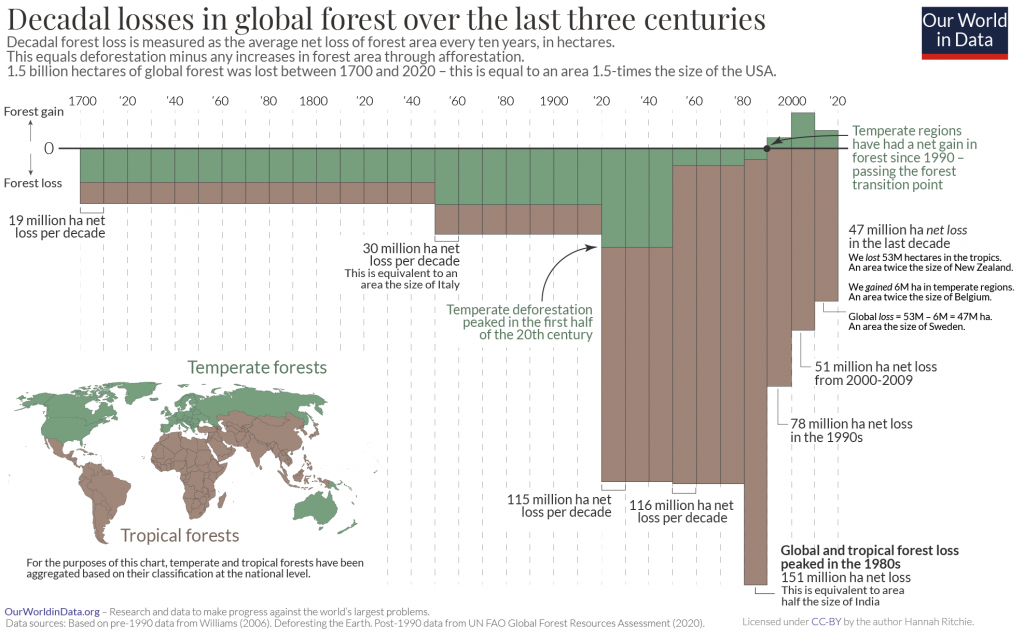How Sustainable Is Balsa Wood? Here Are the Facts
Impactful Ninja is reader-supported. When you buy through links on our site, we may earn an affiliate commission.
Learn more
Learn more
.
Hey fellow impactful ninja ? You may have noticed that Impactful Ninja is all about providing helpful information to make a positive impact on the world and society. And that we love to link back to where we found all the information for each of our posts. Most of these links are informational-based for you to check out their primary sources with one click. But some of these links are so-called "affiliate links" to products that we recommend. First and foremost, because we believe that they add value to you. For example, when we wrote a post about the environmental impact of long showers, we came across an EPA recommendation to use WaterSense showerheads. So we linked to where you can find them. Or, for many of our posts, we also link to our favorite books on that topic so that you can get a much more holistic overview than one single blog post could provide. And when there is an affiliate program for these products, we sign up for it. For example, as Amazon Associates, we earn from qualifying purchases. First, and most importantly, we still only recommend products that we believe add value for you. When you buy something through one of our affiliate links, we may earn a small commission - but at no additional costs to you. And when you buy something through a link that is not an affiliate link, we won’t receive any commission but we’ll still be happy to have helped you. When we find products that we believe add value to you and the seller has an affiliate program, we sign up for it. When you buy something through one of our affiliate links, we may earn a small commission (at no extra costs to you). And at this point in time, all money is reinvested in sharing the most helpful content with you. This includes all operating costs for running this site and the content creation itself. You may have noticed by the way Impactful Ninja is operated that money is not the driving factor behind it. It is a passion project of mine and I love to share helpful information with you to make a positive impact on the world and society. However, it's a project in that I invest a lot of time and also quite some money. Eventually, my dream is to one day turn this passion project into my full-time job and provide even more helpful information. But that's still a long time to go. Stay impactful,Affiliate Disclosure
Why do we add these product links?
What do these affiliate links mean for you?
What do these affiliate links mean for us?
What does this mean for me personally?
![]()
Balsa wood is much-loved for its buoyancy and excellent ability to insulate sound, heat, and vibration. It is light-weighted and soft – one of the lightest and softest commercial woods out there (though its density varies significantly depending on the growing conditions). Thanks to the fast growth rate of balsa trees, this timber provides an environmentally friendly alternative for many products, for example, a surfboard blank. Still, we had to ask: How sustainable is balsa wood?
Balsa wood is sustainable because balsa trees capture carbon from the atmosphere, while balsa products work as long-lasting carbon storage. Balsa trees’ fast-growing nature means the timber is more sustainable than many other tropical timbers such as ipe, which comes from very slow-growing trees.
In this article, we’ll walk you through the life-cycle of balsa wood used for furniture and other household items. Then, we evaluate its sustainability, potentials, and shortfalls. And in the end, we’ll show you tips for buying sustainable balsa wood.
Here’s How Sustainable Balsa Wood Is
Balsa wood is a sustainable material because of the balsa trees’ carbon sequestration potential and the carbon offset value at the end of any products made with balsa wood. Furthermore, as balsa trees grow quickly, the forests or plantations can replace any timber cut down (for making furniture and household items) at a rapid rate.
“Sustainable: The ability to be maintained at a certain rate or level | Avoidance of the depletion of natural resources in order to maintain an ecological balance”
Oxford Dictionary
To understand the sustainability of balsa wood, we assess the life-cycle of furniture and household items. This life-cycle assessment (LCA) is a method to evaluate the environmental impacts of each stage in a product’s life cycle, from the making to the recycling. Over the years, companies have strategically used LCA to research and create more sustainable products.
In this article, we’ll use the cradle-to-grave perspective of the LCA, examining the five stages of the life-cycle of furniture made with balsa wood.
| The life-cycle stages of balsa wood | Each stage’s sustainability |
| Growing of balsa wood | Growing balsa trees is sustainable thanks to the carbon sequestration potential and the fast growth rate of the balsa species. |
| Manufacturing of balsa wood | Turning balsa wood into furniture has a relatively low carbon footprint because wood waste can be recycled fully as by-products or biomass pellets to offset the carbon emissions during harvesting and processing. Significant reduction in carbon emissions can also come from using fossil-free energy. |
| Transporting of balsa wood | Transporting is a relatively carbon-intensive stage in the life cycle of balsa furniture due to the long distances from its source and emissions associated with operating the hauling vehicles that take timber to sawmills and factories, then furniture to stores. Most balsa wood comes from the jungles in Central and South America. Thus, transporting balsa wood furniture would typically have a higher carbon footprint than transporting furniture made with regionally available wood. |
| Usage of balsa wood | Using balsa products can be sustainable thanks to the carbon capture during the products’ long life. |
| End-of-life of balsa wood | The end-of-life stage for balsa furniture is sustainable when the wood is reused or burned as bioenergy. |
Overall, balsa wood is sustainable. However, the actual environmental impact of a particular product, like a buoy or a surfboard blank, depends on many factors, especially the distance and mode of transportation. Let’s dive deeper into each stage and find out how it can be more sustainable.
How Sustainable Is the Growing of Balsa Wood
Growing balsa trees is sustainable thanks to the carbon sequestration potential and the fast growth rate of the balsa species.
What Type of Wood is Balsa and What Does This Mean for Sustainability
Balsa wood falls into the hardwood category even though it is relatively soft. That is due to balsa trees having broad leaves (in contrast with softwood species’ needle-like leaves).
The balsa tree species is scientifically known as Ochroma pyramidale. It also has an old scientific name as Ochroma “lagopus,” because its fruit resembles a large rabbit’s foot when open.
This tree species grows rapidly. They reach a height of 60 to 90 feet tall and a diameter of 3 to 4 feet within six to 10 years and will then be ready for harvesting. That is a considerably faster growth rate than some other timber trees like ipe or cumaru, which also grow in the tropical regions of the Americas. Teak – another tropical plant, typically only reaches after 60 years in a plantation and after 80 years in the wild.
How Sustainable Is the Growing Balsa Wood
Balsa timber’s sustainability lies in the potential for carbon sequestration, its large fast growth rate, and its potential in agroforestry systems.
- Carbon sequestration: As balsa trees grow, they absorb CO2 from the atmosphere while releasing oxygen. During their lifespan, they act as a carbon sink. This means that they are taking greenhouse gasses out of the atmosphere, helping to mitigate the climate crisis. And they can store a significant amount of carbon, growing as tall as 90 feet with a trunk of 4 feet in diameter.
- Fast replacement rate: The rapid growth of balsa trees indicates the ability to replace balsa timber cut down for making furniture or household items. As a balsa tree typically takes less than a decade to mature, it is relatively fast for the forest or plantation to replace any cut balsa timber. Thus, in this sense, balsa wood is more sustainable than slow-growing tropical hardwood species, such as ipe or teak.
- Agroforestry land usage: Balsa trees are a good component in agroforestry systems (i.e., the intentional combination of agriculture and forestry to create productive and sustainable land-use practices).
The Ochroma pyramidale species are pioneer trees. They grow fast and colonize a clearing rapidly, i.e., afforesting the land. Also, their extra-large leaves provide shade to the young seedlings of the slower-growing tropical trees. Such trees could later provide timber or other forestry products (after balsa harvest finishes).
Agroforestry systems such as those stay productive over a long period and prevent new forest lands from being cleared, as in slash-and-burn agriculture.
Where Is Balsa Wood Usually Grown
Balsa trees grow naturally in the humid rainforests throughout the tropical regions of the Americas. The natural north-south range of this tree species runs from Guatemala to Bolivia. Ecuador – on the west coast of South America – is home to most of the balsa stock in the world.
Balsa trees have also been introduced, as a timber crop, into countries in other parts of the world, like Papua New Guinea, Indonesia, Thailand, and the Solomon Islands.
In the wild, balsa trees grow best in high ground between tropical rivers where it is warm with plenty of rainfalls and good drainage. However, they grow sparsely – only one or two basa trees to an acre of the jungle. And this low density might lead to unnecessary cutting down of other trees (i.e., clear-cutting) to reach a balsa tree.
As the balsa trade booms, illegal logging becomes a serious problem, especially in areas reserved for the indigenous Amazonian communities in Ecuador. For example, the banks of several rivers leading to the Pastaza River Basin are under intense deforestation as illegal loggers chop down balsa trees and use the rivers to transport the timber.
In plantations, balsa trees can be planted at a much higher density. With 400 balsa trees per acre, for example, plantations can easily provide a large amount of timber for commercial operation. However, plantations often have much poorer biodiversity.
Well-designed agroforestry systems can be the middle ground, harboring more wildlife than plantations yet being more productive than jungles.
Harvesting wood from natural forests can result in biodiversity loss regarding the tree species and wild animals that feed and shelter in the forests.
One example is when loggers selectively fell the biggest and tallest trees. That pattern would cause a reduction in the genetic diversity and quality of the trees within the stand, leading to gradual degradation of tree quality.
Cutting down balsa trees also disrupts the forests’ wild animals, which depend on the forest for food and shelter. Balsa is a flowering tree species that attract capuchin monkeys during the day and kinkajou and olingo – two small, nocturnal, arboreal mammals – and bats at night. The jungles where balsa trees are found are also home to birds of different species, such as herons, parrots, macaws, and big animals, including jaguars, deer, and capybaras.
The Amazon rainforest is one of the most biodiversity places on earth. It hosts about one-third of the world’s tropical trees (over 2,500 tree species). Thus, cutting down trees, especially illegally and unsustainably, and displacing animals in the Amazon Rainforest has a huge ecological cost.
The only way for you as a consumer to tackle problems caused by illegal logging is to source sustainable woods. We will point you in the right direction with balsa wood at the end of this article.
In total, logging of forestry products from plantations accounts for 26% of forest loss, which is a combination of deforestation and forest degradation. However, the loss in bio-diverse forests in tropical climates is more significant (and sometimes less properly recorded) than in temperate, well-managed logging forests.

How Sustainable Is the Manufacturing of Balsa Wood
Turning balsa wood into furniture has a relatively low carbon footprint because wood waste can be recycled fully as by-products or biomass pellets to offset the carbon emissions during harvesting and processing. Significant reduction in carbon emissions can also come from using fossil-free energy.
The first step of manufacturing balsa furniture involves cutting down trees and turning them into lumber in a sawmill. The carbon emissions here come from electricity usage.
The next step is to dry lumber before turning it into furniture. If a piece of lumber can be air-dried to the desired moisture content, no added energy is needed for this step. However, if a kiln is used, it requires extra energy. This could mean higher carbon emissions depending on the source of the energy.
Kiln drying is often the preferred method (for drying balsa wood) to air-drying as the former has a lower risk of wood splitting and warping. However, kiln drying can take up to two weeks as green balsa wood contains a lot of water – five times as much water by weight as it has actual wood substance. This is a special feature of balsa as most hardwoods contain very little water besides the more substantial wood substance.
If fossil fuels are used to operate a kiln for as long as two weeks, it would significantly increase the total carbon emissions.
Burning wood waste (biomass), however, can generate energy to replace fossil fuels. Luckily, at least 90% of all thermal energy used for kiln drying in the US hardwood sector comes from biomass (instead of fossil fuels).
Balsa wood is very easy to work with, meaning there is no need for heavy machines (and fuel to run them) while turning the wood into furniture. This factor also contributes to balsa wood being a sustainable material.
How Sustainable Is the Transportation of Balsa Wood
Transporting is a relatively carbon-intensive stage in the life cycle of balsa furniture due to the long distances from its source and emissions associated with operating the hauling vehicles that take timber to sawmills and factories, then furniture to stores.
Most balsa wood comes from the jungles in Central and South America. Thus, transporting balsa wood furniture would typically have a higher carbon footprint than transporting furniture made with regionally available wood, like maple or pine.
The actual emission during the transporting stage depends on the type of vehicles used, the fuel they need, and the distance the wood travels. Calculations made by the Norwegian Forest and Landscape Institute showed that smaller wood hauling trucks emitted more CO2 per transported cubic meters of timber: 1.25 times more than larger wood hauling trucks, 1.3 times more than sea vessels, and six times more than freight trains. Therefore, the sustainable transportation option would be rail or large trucks running on biofuel. You can check with your wood suppliers how their products are transported to and within the US and opt for the more sustainable option.
How Sustainable Is the Usage of Balsa Wood
Using balsa products can be sustainable thanks to the carbon capture during the products’ relatively long life.
Balsa wood is often considered the strongest wood for its weight. It is stronger in some respects than pine, hickory, or even oak when comparing the strength per unit of weight. Because of its buoyancy and lightness, it is great in products like buoys, rafts, surfboards, model airplanes, and musical instruments.
Furniture and household items made with balsa wood can benefit from this material’s durability (and sustainability). Balsa wood surfboards, for example, are stronger than a regular polyurethane board and easily last for a decade or more.
When wood is decayed, either naturally in the forest or because of damage caused by usage at home, the carbon stored in the wood is released back to the atmosphere. Therefore, long-lasting furniture can be considered a good way of keeping carbon out of the atmosphere. If the wood is reclaimed for making another piece of furniture, its positive carbon storage environmental impact is even higher.
How Sustainable Is the End-of-Life of Balsa Wood
The end-of-life stage for balsa furniture is sustainable when the wood is reused or burned as bioenergy.
There are a few scenarios for wood products – furniture or musical instruments – at the end of their life:
- They can end up in landfills and don’t decompose. In this case, it keeps its role as carbon storage.
- Wood products can also be upcycled and reused, extending their role as carbon storage and reducing the fossil CO2 emitted as much as four times when comparing, for example, a recovered hardwood flooring with a new one. New wood products often travel much further to their markets, compared with recovered wood products. The latter is typically made in urban centers and sold locally, which lowers the transportation environmental burdens.
- In another end-of-life scenario, products like a balsa cabinet can be burned for biomass energy displacing coal or natural gas in generating electricity.
With smaller items, the offset won’t be as high as there is much less waste for burning. However, if such products are made from manufacturing wood waste as by-products, their carbon footprint is minimal.
When comparing a balsa wood blank to a foam blank in a surfboard, for example, the balsa option is a lot more sustainable.
At the beginning of the life cycle, balsa trees grow and help mitigate climate change. In contrast, the making of foam blanks requires fossil fuels and toxic ingredients – both harmful to the earth.
In the end, balsa blanks can be fully recycled. In contrast, foam blanks will likely stay around for generations, slowly polluting our soil and drinking water.
How Can You Buy Balsa Wood More Sustainably
The key to sustainably buying any wood is to check on relevant environmental and original certifications. Reliable certifications for sustainable woods are:
An FSC certification ensures that the balsa wood comes from responsibly managed forests that provide environmental, social, and economic benefits.
PEFC’s approaches to sustainable forest management align with protecting the forests globally and locally and making the certificate work for everyone. Getting a PEFC certification is strict enough to ensure the sustainable management of a forest is socially just, ecologically sound, and economically viable but attainable not only by big but small forest owners.
Why Is It Important to Buy More Sustainable Wood
Buying sustainable wood also means helping to prevent illegal or unsustainable logging, which harms the forests’ biosystems and accelerates climate change.
Logging of forestry products from plantations accounts for 26% of forest loss. Cutting down trees for wood has a lesser impact on carbon storage than digging up the whole forest floor and turning it into farms or mines. However, if logging is not sustainably managed, it can badly damage wildlife.
When logging happens in tropical forests – the bio hotspots of our planet – the biodiversity loss can be much more damaging. Subtropical and tropical forests are packed with unique wildlife – endemic mammals, birds, and amphibians. The displacement of such wildlife during poorly managed logging would be a major contributor to global biodiversity loss.
Sustainable management of forests also means that trees are cut down for timber only when they are mature. These trees will then be able to regrow and eventually replace the loss of canopy, absorb carbon from the atmosphere and reduce the effect of climate change.

Final Thoughts
You can buy sustainable products made from balsa wood as long as the material comes from verified sources that follow sustainable management practices. Verifying the source is essential due to the increased risk of illegal logging and trading of balsa. Opt for the wood that travels the shortest distance using the greenest mode of transportation. And, to make it even more sustainable, use any balsa items for as long as you can, upcycle the material to extend its usage, and arrange for it to be recycled fully.
Stay impactful,

Sources
- Science Direct: Life-cycle assessment (LCA)
- MIT SMR: Strategic Sustainability Uses of Life-Cycle Analysis
- European Environment Agency: cradle-to-grave
- THE WOOD DATABASE: BALSA
- Impactful Ninja: How Sustainable Is Ipe Wood? Here Are the Fact
- Impactful Ninja: How Sustainable Is Cumaru Wood? Here Are the Fact
- Impactful Ninja: How Sustainable Is Teak Wood? Here Are the Fact
- US DEPARTMENT OF AGRICULTURE: Agroforestry Practices
- PROTA4U: Ochroma pyramidale (Cav. ex Lam.) Urb.
- East Coast Model Center: Interesting Facts about Balsa Wood. . .
- Britannica: slash-and-burn agriculture
- MONGABAY: Indigenous Amazonian communities bear the burden of Ecuador’s balsa boom
- Forestry Journal essential ARB: Balsa wood: Where does it come from and why is it so light?
- openDemocracy: The Amazonian Indigenous communities fighting ‘balsa wood fever’ and COVID
- Our World in Data: Deforestation and Forest Loss
- Plants For A Future: Ochroma pyramidale – (Cav.) Urban.
- American Hardwood: Environmental Life Cycle Assessment
- Impactful Ninja: How Sustainable Is Maple Wood? Here Are the Fact
- Impactful Ninja: How Sustainable Is Pine Wood? Here Are the Facts
- Science Norway: Larger logging trucks give less CO2 emissions
- SURF HUNGRY: Best Wooden Surfboards
- Research Gate: Life cycle primary energy and carbon analysis of recovering softwood framing lumber and hardwood flooring for use
- Impactful Ninja: What Is the Carbon Footprint of Biomass Energy? A Life-Cycle Assessment
- SURFER TODAY: The main types of surfboard foam blanks
- FSC: FSC Statement on Myanmar’s Escalating Crisis
- Program for Endorsement of Forest Certification
- Our World in Data: Epidemic Mammal Species




